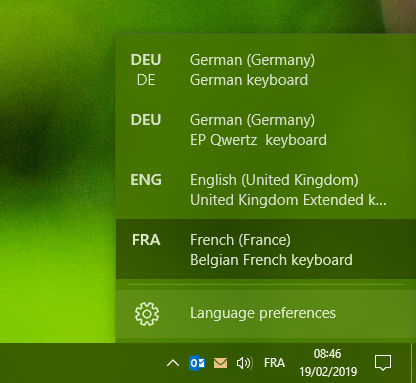Sometimes, the boss enters the room to ask for a simple thing: “If ever you’ve got a couple of minutes…” And sometimes, that very simple thing is not as simple as expected.
It happened to me recently, as I was asked to export a list of the keyboard layouts: “We’re going to migrate computers, we need that list to reinstall them.” OK, it’s quite easy. I mean: it’s just this, right?

It appears that gathering that info is a bit convoluted.
It starts with the Keyboard Layout\Preload key in the user’s registry:
PS> Get-ItemProperty 'HKCU:\Keyboard Layout\Preload'
2 : 00000407
3 : d0010407
1 : 0000040c
4 : 00000809
Those DWORDs are hexadecimal encoded keyboard layout IDs, the lower word being the language LCID (Language Code IDentifier). We can translate those to decimal and get information about the language thanks to .NET:
PS> [int]('0x0407')
1031
PS> [Globalization.CultureInfo]::GetCultureInfo(1031) |
select LCID,Name,NativeName,EnglishName
LCID Name NativeName EnglishName
---- ---- ---------- -----------
1031 de-DE Deutsch (Deutschland) German (Germany)
From there, either the keyboard layout is the default one for the language, or not. If it is not, there will be info in the substitute key:
PS> Get-ItemProperty 'HKCU:\Keyboard Layout\Substitutes\'
d0010407 : 00090407
0000040c : 0007080c
00000809 : 00000452
If there a substitute, the keyboard layout ID is that substitute. If there’s none, we keep the DWORD from the first step (in our example, all but one German keyboard have substitutes).
Each keyboard layout has its own key under Control\Keyboard Layouts in the ControlSet. Each key lists the file containing the layout, and may contain a text description, a display name, or info about where to find it, and sometimes an ID.
gci 'HKLM:\SYSTEM\ControlSet001\Control\Keyboard Layouts\'
Hive: HKEY_LOCAL_MACHINE\SYSTEM\ControlSet001\Control\Keyboard Layouts
Name Property
---- --------
00000401 Layout Display Name : @C:\WINDOWS\system32\input.dll,-5084
Layout File : KBDA1.DLL
Layout Text : Arabic (101)
00000402 Layout Display Name : @C:\WINDOWS\system32\input.dll,-5053
Layout File : KBDBU.DLL
Layout Text : Bulgarian (Typewriter)
00000404 Layout Display Name : @C:\WINDOWS\system32\input.dll,-5065
Layout File : KBDUS.DLL
Layout Text : Chinese (Traditional) - US Keyboard
00000405 Layout Display Name : @C:\WINDOWS\system32\input.dll,-5031
Layout File : KBDCZ.DLL
Layout Text : Czech
00000406 Layout Display Name : @C:\WINDOWS\system32\input.dll,-5007
Layout File : KBDDA.DLL
Layout Text : Danish
...
PS> Get-ItemProperty 'HKLM:\SYSTEM\ControlSet001\Control\Keyboard Layouts\00090407'
layout text : Company Qwertz
Layout id : 737
layout file : kbdgr.dll
PS> Get-ItemProperty 'HKLM:\SYSTEM\ControlSet001\Control\Keyboard Layouts\00000452'
Layout Display Name : @C:\WINDOWS\system32\input.dll,-5145
Layout File : KBDUKX.DLL
Layout Text : United Kingdom Extended
For standard keyboard layout, the display name is translated in the current version language, so the multilingual description is read from a DLL. In PowerShell, it can be done by p/invoking .Net functions, as explained in this StackOverflow answer
As shown with the 00090407 layout in my last example, some ad-hoc layouts do not contain that kind of nicety.
That’s about it. Now, you just have to get that info for the default user (that’s the one used on the logon screen), and load every user registry hive to gather everybody’s settings. Oh, and choose what to display, but everything you need should be at your disposal now.
I’ve had to chase after every little piece of this jigsaw puzzle. Take it brother, may it serve you well.